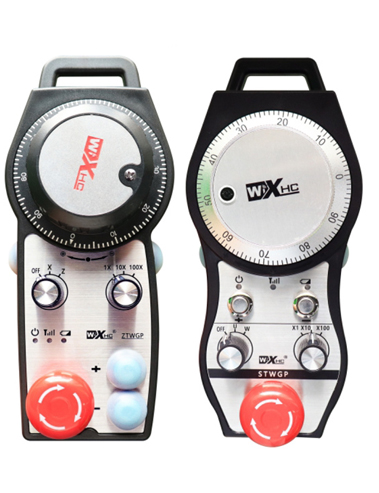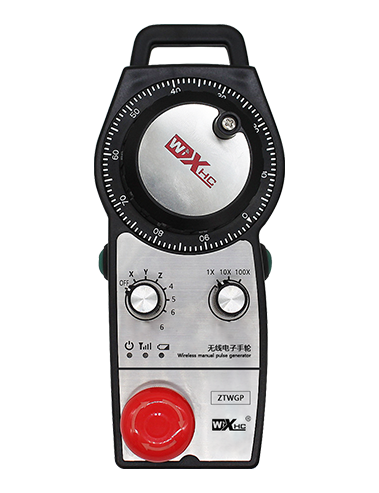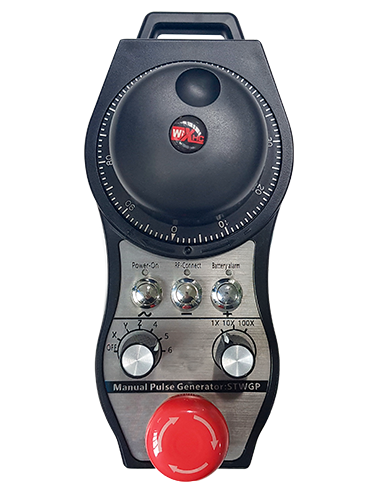Wirelited Wireless maka CNC Vetical Lathe
Nkowa

1.Nmkpọ Okwu mmalite
2. Product functional features
| Operating voltage and current of wireless remote |
3V/14MA
|
| Battery specifications | 2 AA alkaline batteries, size 5 |
| Low voltage alarm range of wireless remote | < 2.3V |
| Receiver power supply voltage | DC5V-24V/A |
| Receiver emergency stop output load range | AC125V-1A/DC30V-2A |
| Receiver enable output load range |
AC125V-1A/DC30V-2A
|
| Receiver custom button output load range | DC24V/50mA |
| Receiver axis selection output load range | DC24V/50mA |
| Receiver magnification output load range | DC24V/50mA |
| Transmission power of handheld terminal |
15dBm
|
| Receiver receiving sensitivity | -100dBm |
| Wireless communication frequency | 433MHz frequency band |
| Wireless communication distance | Barrier free distance of 40 mize |
| Operation temperature | -25℃ < Nke X < 55℃ |
| Anti fall height | 1 (mita) |
| Custom button quantity | 2 |


Ndetu:
① Pulse encoder:
Pịa ma jide bọtịnụ Kwado, shake the pulse encoder, emit a pulse signal,and control the movement ofthe machine axis.
② Enable button:
Press either enable button on either side, and the two sets of enable IO outputs on the receiver will conduct. Release the enable button to disconnect the enable IO output; And before switching the axis selection magnification and shaking the handwheel,the enable button needs to be held down to be effective; This function can be cancelled through configuration software.
③ Indicator lights:
Left side light: power on light,the handwheel uses the axis to select OFF for power on, and this light stays on after power on;
Middle light: a signal light that lights up when operating any function ofthe handwheel, and does not light up when there is no operation;
Right side light: Low voltage alarm light, low battery level,this lightflashes or stays on, battery needs to be replaced.
④ Emergency stop button:
Pịa bọtịnụ Mkpuchi mberede, and the two sets of emergency stop IO outputs on the receiver will be disconnected, and all functions of the handwheel will be invalid.
⑤ Magnification switch:
Press and hold the enable button to switch the magnification switch, which can switch the magnification controlled by the handwheel.
⑥ Axis selection switch (Ike Mgbapụta):
Press and hold the enable button to switch the axis selection switch, which can switch the movement axis controlled by the handwheel. Switch this switch from OFF to any axis and turn on the handwheel power.
⑦ Custom button:
Two custom buttons, each corresponding to an IO output point on the receiver.

6.1 Product installation steps
1. Install the receiver into the electrical cabinet through the buckle on the back, or install it into the cabinet through the screw holes at the four corners of the receiver.
2. Refer to our receiver wiring diagram and compare it with your on-site equipment. Connect the equipment to the receiver via cables.
3.After the receiver is properly fixed, Antenna nwere a ga-ejikọ onye na-anabata ya, and the outer end of the antenna should be installed or placed outside the electrical cabinet. It is recommended to place it on the top of the electrical cabinet for the best signal effect. It is prohibited to leave the antenna unconnected or place it inside the electrical cabinet, as this may result in the signal being unusable.
4. N'ikpaazu, turn on the power switch of the handwheel, and you can operate the machine remotely using the handwheel.
6.2 Mpaghara nnabata

6.3 Onye na-anabata onyinye

7. Product operation instructions
1. Power on the machine and the receiver. The receiver’s working indicator light flashes. Install the battery in the wireless electronic handwheel, secure the battery cover, na
turn on the power switch of the wireless electronic handwheel. The handwheel’s battery level indicator light is on.
2. Họrọ nhazi axis: Pịa ma jide bọtịnụ Kwado, toggle the axis selection switch, and select the axis you want to operate.
3. Họrọ Extinification: Pịa ma jide bọtịnụ Kwado, toggle the magnification switch,and select the desired magnification level.
4. Na-agagharị axis: Pịa ma jide bọtịnụ Kwado, Họrọ Ntinye Axis, select the magnification switch, and then rotate the pulse encoder. Rotate clockwise to move the
positive axis and counterclockwise to move the negative axis.
5. Pịa ma jide bọtịnụ omenala ọ bụla, and the corresponding button IO output of the receiver will be turned on. Release the button, and the output will be turned off.
6. Pịa bọtịnụ Mkpuchi mberede, the corresponding emergency stop IO output of the receiver will be disconnected, the handwheel function will be disabled,release the emergency stop button, the emergency stop IO output will be closed, and the handwheel function will be restored.
7. Ọ bụrụ na anaghị arụ ọrụ maka oge, it will automatically enter sleep mode to reduce power consumption. Mgbe ejiri ya ọzọ, the handwheel can be activated by pressing the enable button.
8. Ọ bụrụ na ejighị aka ahụ ogologo oge, it is recommended to switch the handwheel shaft to the OFF position, Gbanyụọ ike, ma gbasaa ndụ batrị.
8. Nkọwapụta Ngwaahịa Ngwaahịa

① :ZTWGP represents the appearance style
②:Pullet Mmepụta:
01: Indicates that the pulse output signal is A, B; Pount voltaji 5v; pulse quantity 100PPR.
02:Indicating thatthe pulse output signals are A and B; Pulse voltage 12V; pulse quantity 100PPR.
03:Indicating thatthe pulse output signals are A, B, A -, B -; Pount voltaji 5v; pulse quantity 100PPR.
04:Na-egosiputa ngbanye NPN dị ala, ya na mgbaàmà mmepụta nke a na b;The number of pulses is 100PPR.
05:Na-egosiputa ihe ngosi pnp dị elu, ya na mgbaàmà mmepụta nke a na b; The number of pulses is 100PPR.
③:Representing the number of axis selection switches, 2 na-anọchite anya 2 axes.
④:Represents the type of axis selection switch signal, Ihe na-anọchite anya akara ngosi, and B represents encoded output signal.
⑤:Represents the type of multiplication switch signal, Ihe na-anọchite anya akara ngosi, and B represents encoded output signal.
⑥:Represents the number of custom buttons, 2 na-anọchite anya 2 bọtịnụ omenala.
⑦:Represents the power supply for the system handwheel, na 05 na-anọchite anya ikike 5v.
⑧:L represents the left column (left knife holder), and R represents the right column (right knife holder).
9.Solution to Product Malfunctions

1. Biko jiri ya na akọrọ gburugburu ebe obibi na ọnọdụ okpomọkụ na nrụgide ịgbatị ndụ ọrụ ya.
2. Biko zere iji gburugburu ebe obibi dị ka mmiri ozuzo na mmiri mmiri na-agbatị.
3. Biko mee ka ihe dị ọcha dị ọcha ịgbatị ndụ ọrụ ya.
4. Biko zere ịkacha, ida, iferi, wdg. to prevent damage to the precision components inside the handwheel or accuracy errors.
5. Ọ bụrụ na ejighi ya ogologo oge, Biko debe aka na ebe dị ọcha ma dị mma. N'oge nchekwa na njem, A ga-akwụ gị ụgwọ na mmiri na-eguzogide.
11. Ozi Nchedo
1. Biko gụọ ntuziaka ahụ nke ọma tupu iji ya ma gbochie ndị ọkachamara na-abụghị ndị ọrụ.
2. Please replace the battery in a timely manner when the battery level is too low to avoid errors caused by insufficient battery power and inability to operate the handwheel.
3. Ọ bụrụ na achọrọ mmezi, Biko kpọtụrụ onye nrụpụta. Ọ bụrụ na mmebi nke onwe, Onye na-emepụta ahụ agaghị enye akwụkwọ ikike





